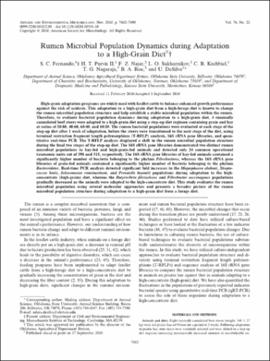| dc.contributor.author | Fernando, S. C. | |
| dc.contributor.author | Purvis, H. T., II | |
| dc.contributor.author | Najar, F. Z. | |
| dc.contributor.author | Sukharnikov, L. O. | |
| dc.contributor.author | Krehbiel, C. R. | |
| dc.contributor.author | Nagaraja, T. G. | |
| dc.contributor.author | Roe, B. A. | |
| dc.contributor.author | DeSilva, U. | |
| dc.date.accessioned | 2018-08-29T14:24:30Z | |
| dc.date.available | 2018-08-29T14:24:30Z | |
| dc.date.issued | 2010-11 | |
| dc.identifier | oksd_fernando_rumenmicrobialp_2010 | |
| dc.identifier.citation | Fernando, S. C., Purvis, H. T., II, Najar, F. Z., Sukharnikov, L. O., Krehbiel, C. R., Nagaraja, T. G., ... DeSilva, U. (2010). Rumen microbial population dynamics during adaptation to a high-grain diet. Applied and Environmental Microbiology, 76(22), 7482-7490. https://doi.org/10.1128/AEM.00388-10 | |
| dc.identifier.uri | https://hdl.handle.net/11244/301605 | |
| dc.description.abstract | High-grain adaptation programs are widely used with feedlot cattle to balance enhanced growth performance against the risk of acidosis. This adaptation to a high-grain diet from a high-forage diet is known to change the rumen microbial population structure and help establish a stable microbial population within the rumen. Therefore, to evaluate bacterial population dynamics during adaptation to a high-grain diet, 4 ruminally cannulated beef steers were adapted to a high-grain diet using a step-up diet regimen containing grain and hay at ratios of 20:80, 40:60, 60:40, and 80:20. The rumen bacterial populations were evaluated at each stage of the step-up diet after 1 week of adaptation, before the steers were transitioned to the next stage of the diet, using terminal restriction fragment length polymorphism (T-RFLP) analysis, 16S rRNA gene libraries, and quantitative real-time PCR. The T-RFLP analysis displayed a shift in the rumen microbial population structure during the final two stages of the step-up diet. The 16S rRNA gene libraries demonstrated two distinct rumen microbial populations in hay-fed and high-grain-fed animals and detected only 24 common operational taxonomic units out of 398 and 315, respectively. The 16S rRNA gene libraries of hay-fed animals contained a significantly higher number of bacteria belonging to the phylum Fibrobacteres, whereas the 16S rRNA gene libraries of grain-fed animals contained a significantly higher number of bacteria belonging to the phylum Bacteroidetes. Real-time PCR analysis detected significant fold increases in the Megasphaera elsdenii, Streptococcus bovis, Selenomonas ruminantium, and Prevotella bryantii populations during adaptation to the highconcentrate (high-grain) diet, whereas the Butyrivibrio fibrisolvens and Fibrobacter succinogenes populations gradually decreased as the animals were adapted to the high-concentrate diet. This study evaluates the rumen microbial population using several molecular approaches and presents a broader picture of the rumen microbial population structure during adaptation to a high-grain diet from a forage diet. | |
| dc.format | application/pdf | |
| dc.language | en_US | |
| dc.publisher | American Society for Microbiology | |
| dc.rights | This material has been previously published. In the Oklahoma State University Library's institutional repository this version is made available through the open access principles and the terms of agreement/consent between the author(s) and the publisher. The permission policy on the use, reproduction or distribution of the material falls under fair use for educational, scholarship, and research purposes. Contact Digital Resources and Discovery Services at lib-dls@okstate.edu or 405-744-9161 for further information. | |
| dc.title | Rumen microbial population dynamics during adaptation to a high-grain diet | |
| osu.filename | oksd_fernando_rumenmicrobialp_2010.pdf | |
| dc.description.peerreview | Peer reviewed | |
| dc.identifier.doi | 10.1128/AEM.00388-10 | |
| dc.description.department | Animal Science | |
| dc.type.genre | Article | |
| dc.type.material | Text | |
| dc.subject.keywords | bacteria | |
| dc.subject.keywords | biodiversity | |
| dc.subject.keywords | cattle | |
| dc.subject.keywords | dna fingerprinting | |
| dc.subject.keywords | edible grain | |
| dc.subject.keywords | metagenome | |
| dc.subject.keywords | phylogeny | |
